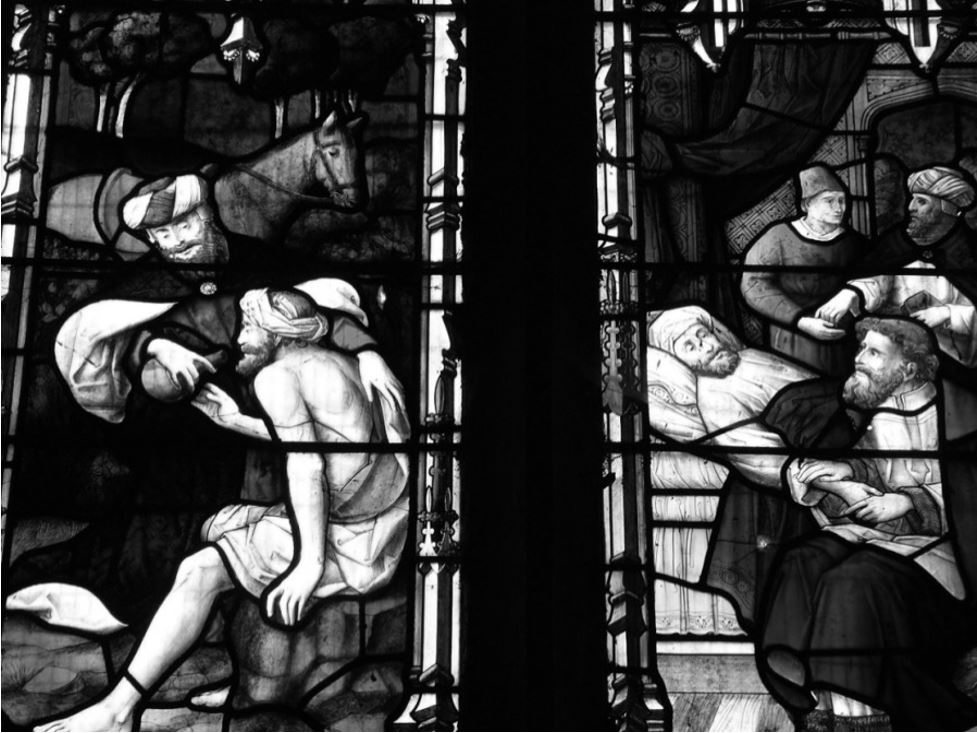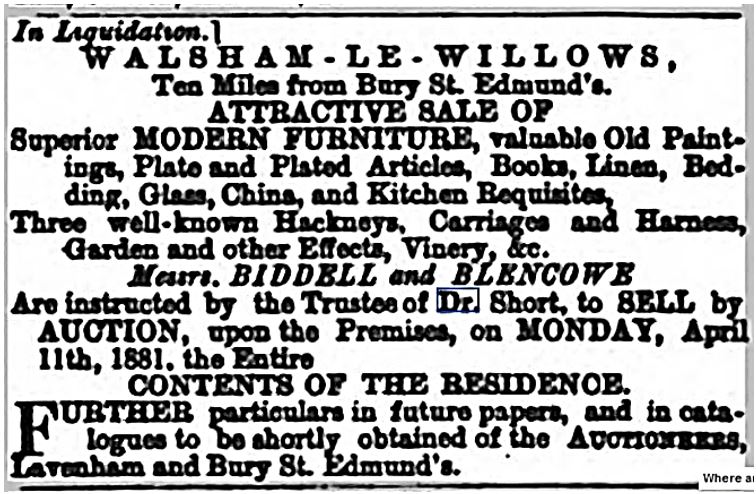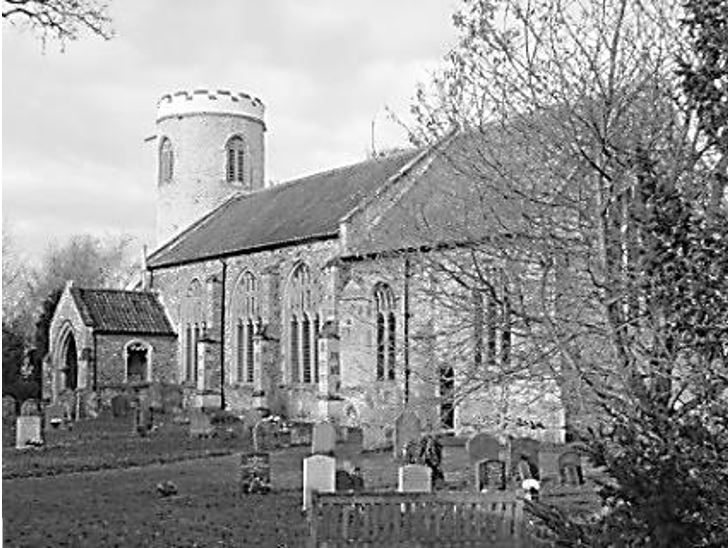Dr William Hooper Short – 2
(Continued)
On 17th September 1878 Walsham le Willows celebrated the restoration and re-opening of St Mary’s Church after two years of extensive work. Of the total cost of £2,000 (£100,000 today) for the full project, the cost of the new roof for the chancel and its subsequent redecoration, totalling £800, was paid by John Martineau. The balance for the work throughout the rest of the church was raised by voluntary contributions from other benefactors and the community[1]. Following an elaborate service in the packed church, Dr Short was prominent among the list of dignitaries at the subsequent celebratory lunch (“elegantly” catered by Mr Carpenter of the Blue Boar) in a marquee in the grounds of Walsham Hall across the road. The accompanying complimentary speeches were notable in their praise for all concerned, with a great deal of mutual congratulation on what was obviously an event of considerable local satisfaction[2].
Inspired by the occasion, Dr Short was credited with suggesting that a suitable memorial to the event would be the creation of stained glass panels to re-glaze the West Window of the church. He also undertook to collect the necessary funds, “which met with widespread approval” and in the following weeks he raised the appropriate sum, between £70 and £80, chiefly, according to reports, from the ranks of the local medical profession. Records of similar other windows of the same time show that they too cost “less than £100” or £5,000 today.
To reflect the source of the funds Dr Short and Mr T M Golding (Church Warden) then chose a design based on the story of ‘The Good Samaritan’ which was said to be “in harmony with the beneficent work in which the principal donors are frequently engaged — that of ministering to the wants of the necessitous sick”[3]. The work was commissioned from Messrs Lavers, Barraud and Westlake, a leading and long-established firm of stained glass manufacturers in London. By that time Nathaniel Hubert John Westlake (1833-1921) was effectively in charge of the firm, and its principal designer. He ran a large studio, and the production process based on his designs was necessarily devolved among many craft workers[4]. The new window was duly unveiled at a church service on 7th September 1879. A collection was made at the service for the Suffolk Medical Club, one of a number of ‘Friendly Societies’ supported by local doctors for the benefit of their patients, and established to pay for the medical expenses of their members on the basis of mutual insurance.

Throughout 1880 life progressed as before. It may be of interest that at a local coroner’s inquest on the death of a four-year old child in his sleep in January that year, Dr Short’s evidence was given to a jury chaired by Mr Harry Drake, the Walsham dentist of the time. In May at the AGM of the Walsham Cricket Club the Treasurer, Dr Short, was complimented on his success in returning the Club’s funds to a positive situation. At a concert in the Public hall later that month[5] Messrs. Short, Cawston[6], and Taylor[7] not only performed various songs together, but Dr Short “lent his piano” for the occasion.
This continuous involvement with the community made it all the more astonishing that on 28th January 1881 The London Gazette carried the notice of the
“First General Meeting of Creditors under The Bankruptcy Act, 1869 In the County Court of Suffolk, holden (sic) at Bury St. Edmunds, In the Matter of a Special Resolution for Liquidation by Arrangement or Composition with Creditors, Instituted by William Hooper Short, of Walsham-le-Willows, in the County of Suffolk, Physician, Surgeon, and Apothecary.”
Dr Short, professional man and respected local figure, had had the conclusion thrust upon him that his personal finances were out of control – he was insolvent and unable to pay his debts, and he faced disgrace as he threw himself on the mercy of his creditors. And they were many.
The formal Meeting of Creditors was held at the Guildhall, Bury St Edmunds on Tuesday 15th February 1881 with Eldred Edmund Clayton[8] in the chair. He had been designated ‘Receiver’[9]. Mr W. Salmon, noted Bury Solicitor and Town Clerk, was acting for Dr Short, and Mr Lancelot Lane for the family of Mrs Short. Among the other lawyers present was Mr Chittock from Norwich who had been retained by the Walsham creditors to present a coordinated view, and voice, on their behalf. But the creditors were spread far and wide. In Walsham he owed money to the butcher (in fact two butchers: Mr Cawston – with whom he sang – and Mr Blizzard[10]), the baker (Mr Kenny) and, if not a candlestick-maker, a Master Watchmaker and Gunsmith, William Last. He owed money to Mr Nunn the builder, Mr Harrington the Pharmaceutical Chemist and Stationer, grocers, drapers, tailors, carpenters, farmers and so on.
He owed money throughout East Anglia. In Ipswich his creditors included Schulen and Boby, watchmakers, The East Anglian Daily Times, and Messrs Botwood, carriage manufacturers, who had repossessed the vehicle in question for lack of payment. He also owed money in Norwich, Diss and Bury St Edmunds. He owed £70 for wine and £100 for corn for the horses. The debts were analysed and duly proved as Mr Salmon produced a Statement of Affairs for the meeting. Many of the amounts were small (under £10, equivalent to £400 today) but in total they came to the equivalent of £75,000. In assets he was owed an average of £3 each by some 300 patients, but many would not be able to pay him and the costs of collection would be high. Mr Blencowe the Bury auctioneer valued Dr Short’s furniture for sale purposes at £422.9s. Under the rules of bankruptcy, the wages he owed to Mr Taylor his assistant (and singing companion), his gardener, groom, housemaid and cook had preferential claim on the estate together with any unpaid rent and taxes. He was however entitled to keep his livelihood, his medical practice, although its value in these circumstances was problematical.
The whole process, diligently reported in the local press, was conducted with noise and argument and even raucous laughter, and was quite humiliating. It had to be established that Mrs Short’s money was her own, and that a Life Insurance Policy on her life had been mortgaged, and that she used her own investment income to clothe herself. The maintenance of his widowed mother in Ashfield and of his widowed sister’s child were also mentioned in mitigation. His bookkeeping was poor, his optimism unquenchable, but basically the income from his practice, £1200 per annum – or perhaps half that in reality – had been insufficient over the years to fund the apparently necessary expenses of his lifestyle.
It transpired that the Walsham creditors were united in wanting to push for full Bankruptcy in a hearing before a County Court Judge, despite the extra costs this would incur. They believed that only thus would the full picture – and maximum repayment – be obtained. The remaining creditors who made up the bulk of the debts both by number and total amount were inclined to go for a simpler agreed ‘voluntary liquidation’ which was likely to produce payment of six shillings in the pound (30%). Under the rules such an arrangement might also give an opportunity for a “friend” to step in with financial assistance; in fact no such friend was forthcoming. The reason for the lack of cooperation from the Walsham traders was that they had experienced a very similar blow a little earlier. The previous month an equally significant local figure, Thomas Mingaye Golding, solicitor, Church Warden and member of an established local family, had also placed himself in liquidation at a similar meeting – with the same man acting as Receiver – and so far they had not seen any money.[11]
After much acrimonious debate and a further formal meeting it was finally agreed that the liquidation of Dr Short’s affairs could proceed on the terms negotiated[12]. What was not disclosed by Dr Short at the meeting of creditors, perhaps unsurprisingly, was that he was well aware of the Bankruptcy process. While a medical student, and according to the Edinburgh Gazette at the time, he had been adjudicated Bankrupt on 12th February 1863, twenty years previously. An Order of Discharge from that Bankruptcy was subsequently granted some six weeks later.
But now, financially and socially ruined, the Shorts left Walsham. The April census shows a relative of Mrs Short, Walter Everett (46) of East Harling, merchant, temporarily living at the vacated “Doctor’s House” with his wife. The Short’s furnishings were sold.[13] It was also reported that the Walsham Fire Brigade elected Mr Henry Drake, the dentist, as their new captain.[14].

Also from The Sportsman,
“FOR SALE, at a low figure, the owner having no further use for her, the serviceable well-known GREY COB, late the property of Dr. Short.— Apply to Mr. A. Youngman, Croft-villa, Wattisfield, near Botesdale.”
However Dr Short could still practise as a doctor and he needed to support himself and his family. Where did they go?
Sir Henry Meux, the 2nd Baronet Meux, of Theobalds Park, Hertfordshire, was a very wealthy man. After Eton and Christ Church, Oxford, he had served as High Sheriff for his county and subsequently as an MP, although there is no evidence that he actually ever spoke in the House of Commons. Indeed his only connection with the world of work seems to have been his quarterly visits to the family brewery in the Tottenham Court Road, the source of his wealth, to inspect the accounts. But in adulthood he suffered from a deeply unpleasant, debilitating, and degenerative disease that affected him both mentally and physically. In his final years, certified as ‘lunatic’, he required 24 hour medical attention, provided by a rota of doctors at his Mayfair house, 36 Grosvenor Square. It is staying in that household on the date of the national census in April 1881 that we find Dr W.H. Short and we must assume he was there in a medical capacity looking after Sir Henry. His wife Bessie was staying in a nearby boarding house in Marylebone.
Within a further year the Short family had moved on and established themselves afresh in Reading, Berkshire, where their son Llewellyn had obtained a place at the local Grammar School and Dr Short was back in medical practice. True to form he threw himself wholeheartedly into local activities and his name started to appear in the newspapers again. In April it was reported that he had provided medical assistance to a member of the Salvation Army who had been ‘brutally attacked in the street’.[15] He was appointed surgeon to the Reading Association of Amalgamated Friendly Societies and no doubt it was in that role that he attended the ‘Juvenile Oddfellows’ dinner[16] and the dinner of the local branch of the ‘Foresters Association’ where he replied to the toast for the Medical Officers[17]. His attendance was duly noted at various public gatherings, often of a charitable and social nature including the really quite distinguished Reading and District Angling Association[18]who had presented a trout weighing 16lbs 15ozs to Queen Victoria. He was a speaker at the annual dinner of the Reading Association of Railway Civil Servants[19] and attended a local conference of the Church of England Temperance Society and particularly the examination of the problems of ‘Beer in the Hay and Harvest Field’[20]. Towards the end of 1882 he was back singing again at a fundraising Concert at St Giles Hall, Reading. His rendering of the popular rural ballad “The Farmer’s Boy” (who did of course marry the farmer’s daughter) was, according to the newspaper report, encored enthusiastically[21].
But within a few more months Dr Short was dead. He death occurred suddenly back in East Anglia in Clenchwarton, Norfolk, near Kings Lynn on 27th April 1883. He had apparently been unwell for some weeks and unable to attend to his patients and had gone back to Norfolk to recuperate. His wife Bessie was with him and his death was certified by Charles Plowright the local GP. The causes of death were formally noted on the Death Certificate as ‘Mitral Disease, Albuminuria, and Embolism of Pulmonary Artery’.
The newspaper obituary[22] reported that:
“although he had only been in Reading fifteen months, he had gained the respect and esteem of the members of the [Friendly Societies] Association (numbering between 4,000 and 5,000), to whom he was ever attentive and kind. Amongst the members of the medical profession and others with whom the deceased came in contact he had made many friends, and was distinguished for his courteous and genial disposition”.
He is buried in the churchyard of St Mary the Virgin, complete with its iconic East Anglian round tower, in the tiny hamlet of East Walton, Norfolk. This forms part of the Westacre estate, ten miles east of Kings Lynn. Dr William Hooper Short was 42 years old when he died. A spark that had shot across those black midnight skies of Walsham was finally extinguished.

Joseph McCann
February 2018
References
[1] Architect: Edward Martineau. Principal contractors: Adams and Cauley of Stanton. Contractors for the chancel: Messrs Hayhoe of Walsham. While the church was closed for 3 months, services were held in Messrs Taylor and Dowson’s malting premises.
[2] BURY AND NORWICH POST Tuesday 24th September 1878
[3] BURY AND NORWICH POST Tuesday 9th September 1879
[4] Note from Mr Martin Harrison FSA
[5] BURY AND NORWICH POST Tuesday 18th May 1880
[6] Local butcher
[7] A visiting surgeon (25) from Westmoreland who was acting as medical assistant to Dr Short and staying at Sunnyside Farm.
[8] Eldred Edmund Clayton (1817-1883) was a retired draper and a long-established member of the Bury St Edmunds commercial community. Upon his death shortly after this time his estate was valued for probate at the equivalent of £5million.
[9] BURY AND NORWICH POST Tuesday 22nd February 1881.
[10] There was earlier tragedy in George Blizzard’s life – his wife Mary had died in childbirth leaving him a widower with 7 small children.
[11] THE LONDON GAZETTE January 21st 1881
[12] DISS EXPRESS Friday 8th April 1881.
[13] EAST ANGLIAN DAILY TIMES Friday 1st April 1881
[14] BURY AND NORWICH POST 10th May 1881:
[15] READING MERCURY Saturday 15 April 1882
[16] READING MERCURY Saturday 25 February 1882
[17] BERKSHIRE CHRONICLE Saturday 21 October 1882
[18] READING MERCURY Saturday 17th February 1883
[19] READING MERCURY Saturday 23 September 1882
[20] READING MERCURY Saturday 07 October 1882
[21] READING MERCURY Saturday 16 December 1882
[22] READING MERCURY Saturday 5th May 1883

